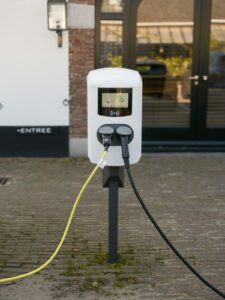
Home / EV Charging News / How DC Fast Charging Stations Work and Why They Are Essential for Commercial EV Charging
Electric vehicles (EVs) are becoming increasingly popular, and as a result, charging infrastructure is growing rapidly to meet the demand. One of the most important components of charging infrastructure is the DC fast charging station. In this article, we will discuss how DC fast charging stations work and why they are essential for commercial EV charging.
DC fast charging stations, also known as Level 3 charging stations, are high-powered chargers that can provide up to 350 kW of power to an EV battery. They are designed to quickly charge the battery of an electric vehicle in about 30 minutes or less, making them an ideal choice for commercial EV charging. Unlike Level 1 and Level 2 chargers, which use AC power, DC fast chargers use direct current (DC) power to charge the battery.
DC fast charging stations use a high-powered DC charger to provide a direct current to the vehicle’s battery. The DC charger converts the AC power from the grid into DC power that can be used by the vehicle’s battery. The charger sends the DC power to the vehicle’s onboard charger, which regulates the amount of power that the battery receives.
While DC fast charging stations offer many benefits for commercial EV charging, it’s important to understand how they compare to Level 1 and Level 2 charging. Level 1 chargers use a standard 120-volt outlet and can provide up to 2 kW of power, while Level 2 chargers use a 240-volt outlet and can provide up to 7.2 kW of power.
While Level 1 and Level 2 charging is suitable for home charging and occasional use, they are not ideal for commercial EV charging. Level 1 charging is too slow to be practical for commercial use, and Level 2 charging takes too long to provide a full charge for an EV battery. In contrast, DC fast charging stations can provide a full charge in about 30 minutes or less, making them the best option for commercial EV charging.
While DC fast charging stations offer many benefits for commercial EV charging, there are some challenges that need to be addressed. One of the biggest challenges is the cost of the charging station. DC fast charging stations are more expensive than Level 1 and Level 2 charging stations, which can be a barrier for some businesses.
Another challenge is the need for a high-powered electrical infrastructure. DC fast charging stations require a high-powered electrical infrastructure to provide the necessary power to the EV battery. This infrastructure can be expensive to install and can require significant upgrades to the electrical grid.
Finally, DC fast charging stations can put a strain on the electrical grid, especially if they are used frequently. To address this challenge, some utilities are working to develop smart charging solutions that can manage the demand for electricity and reduce the strain on the grid.
In conclusion, DC fast charging stations are essential for commercial EV charging, providing a quick charging time, greater range, increased productivity, reduced costs, and environmental benefits. While there are some challenges that need to be addressed, the benefits of DC fast charging stations make them the best option for businesses that rely on electric vehicles. With the continued growth of the EV market, the demand for DC fast charging stations will continue to increase, and businesses that invest in this technology will be well-positioned to take advantage of the many benefits it offers.
DC fast charging stations offer several benefits for commercial EV charging, including:
Any business that relies on electric vehicles can benefit from DC fast charging stations. This includes:
Businesses can take several steps to prepare for the transition to electric vehicles and DC fast charging stations, including:
$2,890.00 Original price was: $2,890.00.$2,790.00Current price is: $2,790.00.
$3,950.00 Original price was: $3,950.00.$3,450.00Current price is: $3,450.00.
$1,650.00 Original price was: $1,650.00.$1,590.00Current price is: $1,590.00.
$2,290.00 Original price was: $2,290.00.$2,150.00Current price is: $2,150.00.
$1,290.00 Original price was: $1,290.00.$799.00Current price is: $799.00.

Your Power Management Partner for Over 25 Years Future Generations Depend on Our Decisions Today ™
2024 © All rights reserved by CyberSwitching